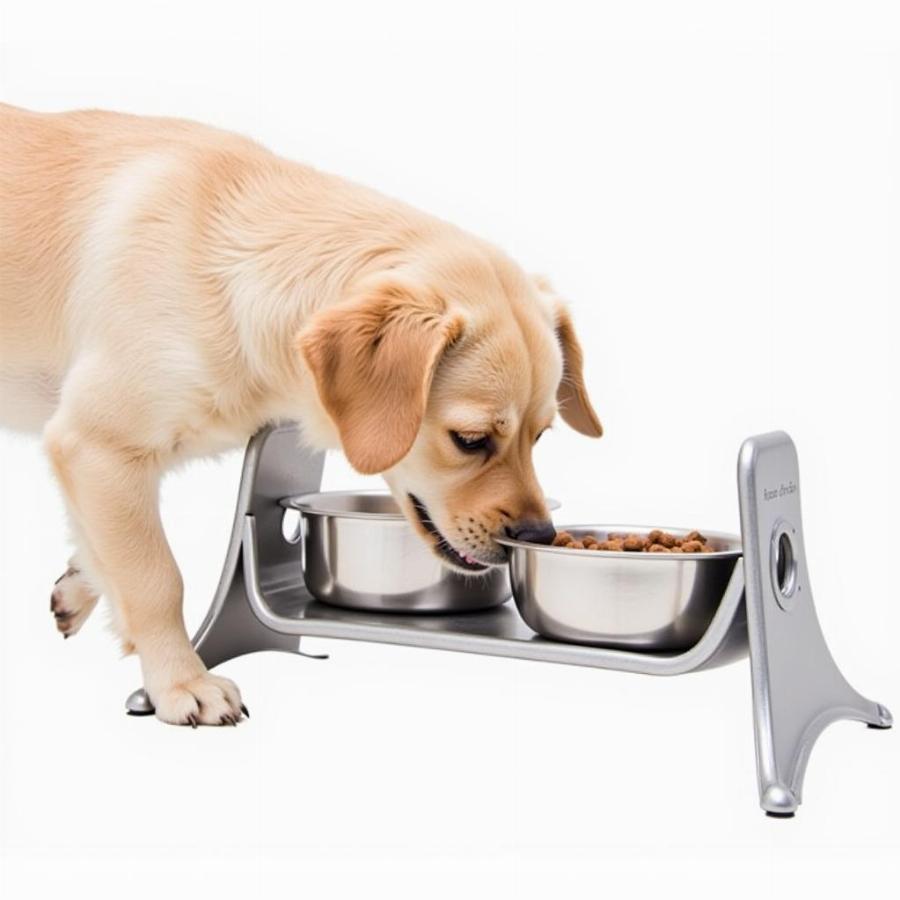Slow eating dog bowls, especially those made of stainless steel, are becoming increasingly popular among pet owners. They offer a simple yet effective solution to a common problem: dogs who gobble down their food too quickly. This can lead to a range of issues, from choking and vomiting to digestive upset and even bloat, a life-threatening condition. A stainless steel slow eating dog bowl helps to pace your dog’s eating, promoting better digestion and overall health. But how do you choose the right one, and what are the benefits? Let’s dive into the world of stainless steel slow eating dog bowls.
Why Choose a Stainless Steel Slow Eating Dog Bowl?
Choosing the right food bowl for your canine companion can significantly impact their mealtime experience. While various materials exist, stainless steel stands out as a durable, hygienic, and safe option, particularly when combined with a slow-feeding design. Stainless steel is non-porous, meaning it doesn’t harbor bacteria or retain odors like plastic bowls can. This makes them easier to clean and more hygienic for your pet. They’re also incredibly durable, resisting rust, chipping, and breaking, even with enthusiastic chewers. This durability makes them a long-term investment, saving you money in the long run. Finally, stainless steel is free of harmful chemicals that can leach into your dog’s food, ensuring their meals are safe and healthy. When these advantages are coupled with a design that promotes slower eating, you’ve got a winning combination for a happier, healthier mealtime.
 Stainless Steel Slow Feeder Dog Bowl for Dogs
Stainless Steel Slow Feeder Dog Bowl for Dogs
Benefits of Slow Eating for Dogs
Why is slowing down mealtimes so important? When dogs eat too quickly, they swallow large amounts of air along with their food. This can lead to bloating (gastric dilatation-volvulus or GDV), a serious and potentially fatal condition. Slow feeder bowls also promote better digestion by encouraging your dog to chew their food more thoroughly. This helps to break down the food into smaller pieces, making it easier for their digestive system to process. Additionally, slowing down mealtimes can be mentally stimulating for your dog, turning mealtime into a fun little puzzle. This can help reduce boredom and anxiety, especially for dogs who tend to scarf down their food and then look for more.
How to Choose the Right Stainless Steel Slow Eating Dog Bowl
Choosing the right slow feeder involves considering your dog’s size, breed, eating habits, and the type of food they consume. Bowls come in various sizes and with different obstacle designs. For small breeds or puppies, a smaller bowl with smaller obstacles is ideal. Larger breeds will need a larger bowl with larger, more challenging obstacles. If your dog is a particularly determined fast eater, you may need to consider a bowl with a more complex design. The shape of the obstacles also matters. Some bowls feature raised ridges or maze-like patterns, while others use scattered bumps or a central cone. The best choice will depend on your individual dog’s needs and preferences.
What if My Dog Doesn’t Like Their Slow Eating Bowl?
Some dogs may be hesitant to use a slow eating bowl at first. It’s important to introduce it gradually. Start by mixing a small amount of their food in the slow feeder with their regular bowl. Gradually increase the amount of food in the slow feeder over several days until they are comfortable eating solely from the new bowl. You can also try adding a small amount of wet food or broth to the slow feeder to make it more appealing. If your dog is still struggling, consider trying a different obstacle design. Sometimes a simple change can make all the difference.
Are Stainless Steel Slow Eating Dog Bowls Dishwasher Safe?
Most stainless steel slow eating dog bowls are dishwasher safe, which makes cleaning a breeze. However, it’s always best to check the manufacturer’s instructions to be sure. Regular cleaning is crucial to maintain hygiene and prevent the buildup of bacteria.
Conclusion
A stainless steel slow eating dog bowl is a valuable investment in your dog’s health and well-being. It can help prevent choking, vomiting, bloat, and other digestive issues while also providing mental stimulation. By carefully considering your dog’s individual needs and choosing the right bowl, you can make mealtimes more enjoyable and healthier for your furry friend. Remember to introduce the new bowl gradually and be patient with your dog as they adjust.
FAQs
- Are stainless steel slow feeder bowls safe for all dogs? Yes, stainless steel is a safe and non-toxic material for dogs.
- How do I clean a stainless steel slow feeder bowl? Most are dishwasher safe, but check the manufacturer’s instructions.
- What if my dog still eats too fast even with a slow feeder? Consider a bowl with a more complex design or consult with your veterinarian.
- Can puppies use slow feeder bowls? Yes, but choose a bowl with smaller obstacles appropriate for their size.
- Are there any disadvantages to using slow feeder bowls? Some dogs may become frustrated initially, so a gradual introduction is important.
More Helpful Resources on Beaut Dogs
- Check out our article on dog bowls for fast eaters for more tips on slowing down mealtimes.
- Learn about different types of dog bowls and feeders to find the perfect fit for your pet.
- Explore our guide on puzzle dog bowl for mentally stimulating feeding options.
Beaut Dogs is your one-stop resource for all things dog-related, offering expert advice and guidance on everything from breed selection to nutrition and training. We provide reliable and helpful information to empower you to provide the best possible care for your canine companion. For further assistance, please contact us at Email: [email protected] to receive detailed and accurate answers from our Beaut Dogs experts. Visit Beaut Dogs today!